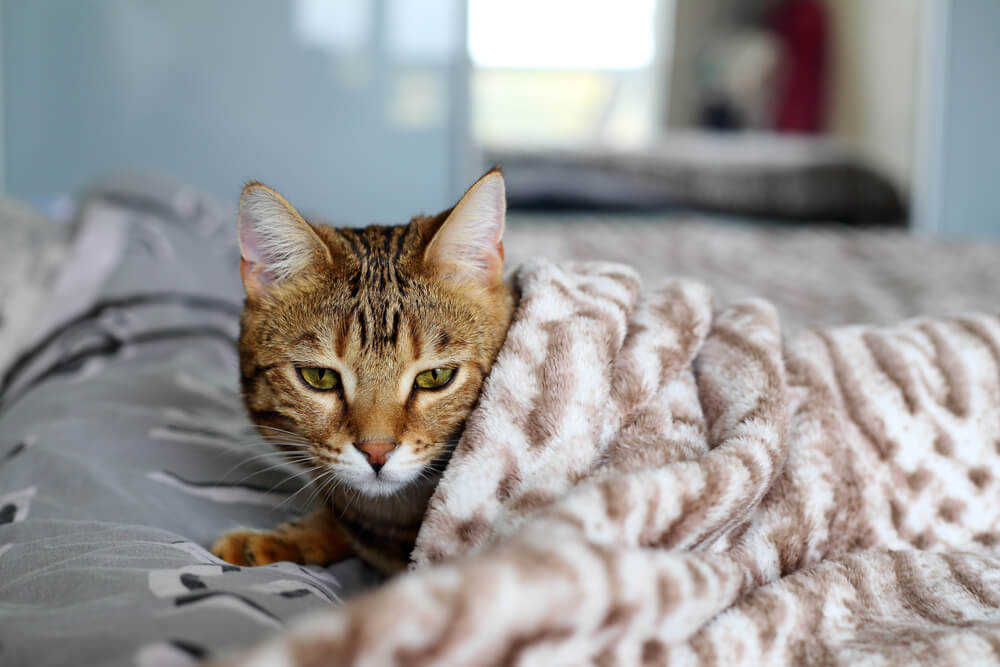Cat vomiting is a prevalent problem, so if your Bengal cat started throwing up recently, and you are reading this article trying to get some help and enlightenment about what is happening, we can assure you that you are not alone.
We will provide the reasons why your Bengal cat is throwing up. We will also touch on the early symptoms of a vomiting cat.
In addition, we look at how to differentiate vomiting from other health conditions that might look similar and, most importantly, what you can do about it.
Cat Vomiting
As we mentioned earlier, cat vomiting is a prevalent issue among many Bengal cat breeders. Cats’ throwing up is so common that people think it’s normal.
Can you imagine if vomiting was so common in humans that it became customary to vomit or see a person vomit at least every day?
Well, that would be quite a reality, but that’s cats for you, and although cat vomiting is super common, it is not a normal condition. There is always an underlying disease, and you can be sure your Bengal cat is sick.
Let’s get straight to the nitty-gritty of Bengal cat vomiting, and hopefully, we can get you some helpful information.
Signs and Symptoms of a Bengal Cat Throwing Up
- The obvious one is vomiting food / undigested food / clear, yellow, or bloody liquid.
- Loss of appetite
- Swollen abdomen
- Diarrhea
- Restlessness / Nausea / Open-mouth breathing/drooling.
- Jaundice
Regurgitation Vs. Vomiting
We have deliberately brought up the topic of regurgitation because it is similar to cat vomiting, and it is crucial to distinguish between the two.
Although similar to vomiting, regurgitation is an entirely different thing that confuses many pet parents.
Regurgitation is passive. In other words, it is a retrograde movement of undigested food inside the body back out through the mouth.
Regurgitation typically happens immediately or fairly soon after meals when the food is still undigested. Regurge mostly occurs in Bengal cats due to a condition known as megaesophagus. Click the link to learn more.
On the other hand, vomiting is the active and forceful expelling of substances inside the body. It requires the cat’s diaphragm and abdominal muscle to contract to force out the stomach contents through the mouth.
What Causes Vomiting?
- Ingestion of substances
- Parasites
- Bacterial infections
- Kidney disease
- Pancreatitis
- Obstipation
- Hypothyroidism
- Liver disease
- Addison’s disease
- Diabetes
- Inflammatory bowel disease
- Food intolerances/allergies
- Cancer
- Nervous system problems include brain tumors, trauma, encephalitis, and vestibular disease.
- Medication includes antibiotics, antifungal medication, non-steroidal anti-inflammatories, and chemotherapy.
- Birth defects
- Stress
Veterinarians classify vomiting into two broad categories based on the reason or cause. The causes can be gastrointestinal or extra-gastrointestinal.
Gastrointestinal problems are problems associated with the digestive tract, while extra gastrointestinal problems are associated with something outside the digestive tract.
Vomiting can be acute or chronic. Acute vomiting happens for less than seven days, while chronic vomiting has been going on for more than seven days. Chronic vomiting can also happen intermittently, which is notorious for giving a false idea that vomiting is normal when it is not.
There are many reasons for your Bengal cat to throw up, which is why it is a common problem. As common as it is, it remains a health problem, and our responsibility is to ensure our little feline friends are healthy and happy. So, how can you help treat your Bengal cat? Keep reading!
Treatment of Vomiting in Bengal Cats
It is best to understand that throwing up is not a diagnosis but a symptom you observe. You have to determine the reason for the vomiting, fix it if possible, and control the nausea causing it.
Address the Underlying Cause
Finding the underlying or root cause of your cat’s vomiting will require the assistance of a vet. After running some tests on the cat, they may be able to make the correct diagnosis.
Addressing Dehydration
Most vomiting Bengal cats are dehydrated. Dehydration is normally tough on the pet’s body organs, particularly the kidneys. It is important to rehydrate your cat through intravenous or subcutaneous fluids adequately.
Medication
With the assistance of your vet, get the medication that will prevent nausea and return their appetite for food and play. The vet may also inject the appropriate drug to counter the diagnosed disease.
Change the Diet
Bengal cats that throw up most likely have an inflamed gastrointestinal system that needs to heal. The best way to heal the tract is to feed yours with bland cat foods that are easy to digest.
You can choose between buying therapeutic foods from the big brands and preparing the cat’s meals at home.
Final Word
Vomiting indicates that your cat’s health is deteriorating and that it is better to take the necessary mitigating action is better.
With you is all the information you need to ensure your Bengal cat remains in top health. We hope it is helpful and also wish your cat a quick recovery.














